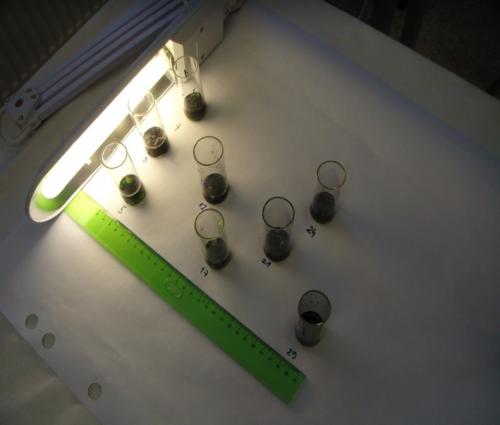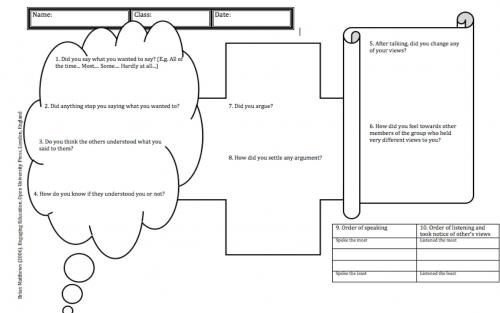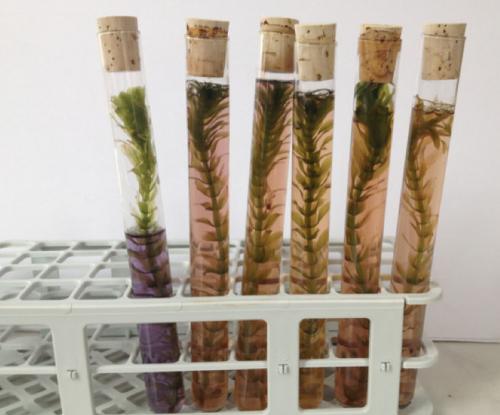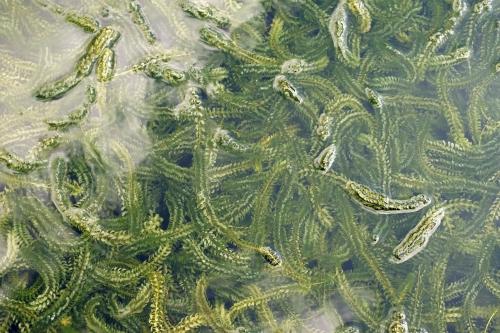The Plant nutrition SAILS inquiry and assessment unit aids students to learn about photosynthesis, a topic that features in curricula for second level education across Europe. In this unit, students use algae immobilised in “jelly balls” to acquire evidence that light is necessary for photosynthesis to occur. Using colorimetric techniques, they observe that when photosynthesis is occurring, carbon dioxide is decreasing in the environment; the change in carbon dioxide concentration causes the pH of the solution to change, as demonstrated by changes in colour of an indicator. These activities help them to connect observed phenomena and scientific theory.
For lower second level, teachers can use a guided inquiry approach; a bounded inquiry approach can be considered at upper second level. Students are provided the opportunity to develop inquiry skills such as planning investigations (planning and rationale, data recording, graphical representation), developing hypotheses, making coherent arguments (reasoning and argumentation) and working collaboratively (discussing their decisions and conclusions). Assessment opportunities include student observation, group discussion or presentation and evaluation of student artefacts.
This unit was trialled in Slovakia, Portugal, Hungary and Sweden, with students aged 12-16 years (7 classes in total, mixed ability and gender). The teaching approach used in all case studies was guided inquiry. Inquiry skills assessed were planning investigations, developing hypotheses, forming coherent arguments, working collaboratively and scientific reasoning. Several assessment methods are described, including classroom dialogue, teacher observation and evaluation of worksheets, presentations or other student artefacts.
- Photosynthesis
- Plants and chlorophyll (leaves, algae)
- Oxygen, light and organic substances
- Carbon dioxide absorption
- Importance of forest and water ecosystems
- Lower
- Upper
- Planning investigations
- Developing hypotheses
- Forming coherent arguments
- Working collaboratively
- Scientific reasoning
- Scientific literacy
- Classroom dialogue
- Teacher observation
- Self-assessment
- Worksheets
- Student devised materials
- Presentations
The activities in the Plant nutrition SAILS inquiry and assessment unit were developed Science & Plants for Schools (SAPS) and adapted for the SAILS project by the team at Univerzita Pavla Jozefa Safárika v Kosiciach (UPJS). This inquiry activity is designed for students aged 12-18 years and can be implemented as a guided or bounded inquiry; students will make some key decisions for their experiments, while other procedures will carried out according to instructions.
Using immobilised algae, students investigate photosynthesis. They can start the activity by preparing immobilised algae (in alginate jelly balls), by dripping an alginate solution, containing the algae, into calcium chloride solution. This is a quick method for generating consistent sized beads in a short time. For the investigation, the beads are placed in indicator solution and positioned at various distances from a light source. Students plan how to measure the quantity of algae used, where to position the samples and how to record their data. The samples are allowed to stand for several hours, after which the effect of changes in carbon dioxide concentration can be observed. Changes in the indicator may be measured using colorimetry, comparison to colour charts or standards or by measuring changes in pH using a pH meter.
This unit is particularly suitable for assessing developing hypotheses, planning investigations, scientific reasoning and scientific literacy, looking at students’ ability to draw conclusions, explain unexpected results, report, compare and discuss results, and provide suggestions about how to improve investigations. Students work in diverse teams (working collaboratively) and produce ideas based on views from team members. Suggested assessment rubrics are provided for evaluation of planning investigations and scientific reasoning.
Below you can find the full inquiry and assessment unit for download, as well as an archive with classroom materials, including student worksheets and assessment tools for teachers to be used during the activities if available.
Unit booklet Classroom materials| Concept focus |
Photosynthesis by algae and carbon dioxide absorption
|
| Inquiry skills focus |
Planning investigations
Developing hypotheses
Forming coherent arguments
Working collaboratively
|
| Scientific reasoning |
Identifying variables
Identifying the inverse relationship of carbon dioxide concentration to light intensity
|
| Scientific literacy |
Explain photosynthesis scientifically
|
| Assessment methods |
Classroom dialogue
Teacher observation
Worksheets
Student devised materials
Presentations
|
This unit was trialled in four countries, producing six case studies of its implementation – CS1 Slovakia, CS2 Slovakia, CS3 Portugal, CS4 Hungary, CS5 Hungary and CS6 Sweden. All the case studies were implemented by teachers who had some experience of teaching through inquiry, but the students involved had not been taught through inquiry in CS1 or CS2 (both Slovakia) and in CS3 Portugal. In CS6 Sweden and CS4 and CS5 (both Hungary) the students had some prior experience of inquiry. The students involved in the case studies were aged 12-16 years and of mixed ability and gender.
The activity was implemented as a 180-minute block in Slovakia. It was divided into two lessons in CS3 Portugal: one 150-minute lesson and another 100-minute lesson. The activity with Elodea (pondweed) instead of algal balls took two 45-minute lessons (CS4 and CS5 Slovakia and CS6 Sweden). In CS3 Portugal and CS6 Sweden, the materials required for the activity were not available, and so the unit was implemented as a theoretical planning investigation. The key skills identified for assessment were planning investigations and forming coherent arguments, as well as associated scientific reasoning capabilities. However, in CS3 Portugal the teacher chose to assess skills in developing hypotheses and working collaboratively. The assessment methods used include classroom dialogue, teacher observation and evaluation of worksheets, presentations or other student artefacts.
The inquiry approach used in all the case studies was that of guided inquiry, i.e. it was guided in the sense that the teacher posed the initial question but there were open inquiry opportunities in that students had freedom in formulation of predictions and planning investigations.
During implementation of the activities in this unit, the optimal number of students per class is 15-18. It is possible to work with classes of about 30 students, but assessment is more difficult for the teacher. With a large number of students an interactive demonstration is recommended, with the inclusion of discussion sequences. Assessment focuses on student proposals relating to the preparation and arrangement of samples, formulation of assumptions and hypotheses.
All teachers organised their students into smaller groups, consisting of 2-4 members. There are examples of single gender groups in CS3 Portugal, and also of mixed-sex groups in all case studies. The students in all of the case studies worked in groups throughout the lessons, but there was variation in both how the groups were chosen and the group size.
Within the six case studies, the inquiry skills of planning investigations, developing hypotheses, working collaboratively, scientific reasoning (arguing for a chosen method, drawing conclusions based on evidence) and scientific literacy were assessed. Formative assessment was useful, in particular for assessment of working collaboratively. Assessment methods included classroom dialogue, teacher observation, evaluation of written artefacts (worksheets, student devised materials, presentations) and self-assessment.
Below you can find the full inquiry and assessment unit for download (excluding the case studies), as well as an archive containing all the case studies.
Unit booklet Case studies| Concept focus |
Development of inquiry skills
Understand the principles of photosynthesis
|
| Activities implemented |
Plant nutrition
|
| Inquiry skills assessed |
Planning investigations
Forming coherent arguments
|
| Scientific reasoning |
Forming conclusions
|
| Assessment methods |
Classroom dialogue
Teacher observation
Self-assessment
Student devised materials
Presentations
|
| Level |
Lower
|
| Age |
12
|
| Prior experience with inquiry |
Some experience
|
| Concept focus |
Development of inquiry skills
Understanding photosynthesis – relationship between light and carbon dioxide
|
| Activities implemented |
Plant nutrition
|
| Inquiry skills assessed |
Forming coherent arguments
|
| Scientific reasoning |
Making predictions
Forming conclusions
|
| Assessment methods |
Classroom dialogue
Teacher observation
Presentations
|
| Level |
Lower
|
| Age |
15
|
| Prior experience with inquiry |
Some experience
|
| Concept focus |
Development of inquiry skills
|
| Activities implemented |
Plant nutrition
|
| Inquiry skills assessed |
Developing hypotheses
Working collaboratively
|
| Assessment methods |
Classroom dialogue
Teacher observation
Self-assessment
Worksheets
|
| Level |
Upper
|
| Age |
15
|
| Prior experience with inquiry |
No experience
|
| Concept focus |
Effect of light on the intensity of photosynthesis
|
| Activities implemented |
Plant nutrition
|
| Inquiry skills assessed |
Planning investigations
Forming coherent arguments
|
| Scientific reasoning |
Defining variables
Argumentation
Forming conclusions
|
| Assessment methods |
Classroom dialogue
Teacher observation
Worksheets
|
| Level |
Upper
|
| Age |
15-16
|
| Prior experience with inquiry |
Some experience
|
| Concept focus |
Effect of light on the intensity of photosynthesis
|
| Activities implemented |
Plant nutrition
|
| Inquiry skills assessed |
Planning investigations
Forming coherent arguments
|
| Scientific reasoning |
Argumentation
Drawing conclusions
|
| Scientific literacy |
Evaluate and design scientific enquiry
Explain phenomena scientifically
|
| Assessment methods |
Classroom dialogue
Teacher observation
Worksheets
|
| Level |
Upper
|
| Age |
15-16
|
| Prior experience with inquiry |
Some experience
|
| Concept focus |
Effect of light and carbon dioxide on rate of growth of algae
|
| Activities implemented |
Plant nutrition
|
| Inquiry skills assessed |
Planning investigations
|
| Assessment methods |
Classroom dialogue
Teacher observation
Student devised materials
|
| Level |
Upper
|
| Age |
14-16
|
| Prior experience with inquiry |
Some experience
|






